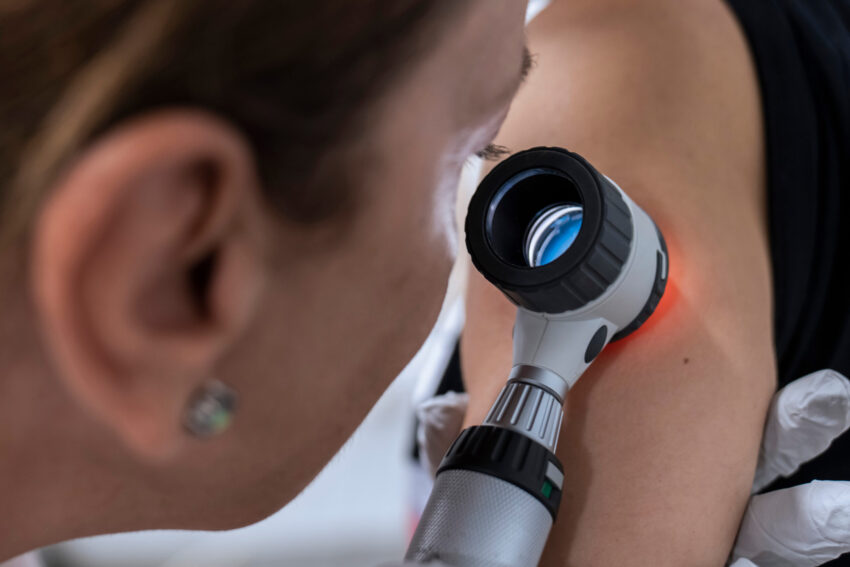Most people including children will have moles. Although moles do not usually cause problematic physical symptoms, they can catch or affect your confidence and self-esteem.
Our adult plastic surgery service at St Thomas’ Hospital and children’s plastic surgery service at Evelina London both provide mole removal treatments. We use the latest technology – including laser mole removal – to produce the best outcomes.
Generally, moles are nothing to worry about. However, you must monitor moles for changes as they can indicate an underlying problem. If your moles change colour, shape, size, bleed or become painful, speak to one of our specialists for an expert opinion.
Private mole removal in London
Our expert plastic surgeons offer same-day removal of moles, birthmarks and skin tags without a referral.
Westminster Bridge Consulting Rooms, based at St Thomas’ Hospital, is home to our team of experts who are committed to pain-free procedures with a reduced risk of scarring.
At our dedicated Children’s Day Surgery Unit, your child can undergo the whole procedure safely and quickly returning home on the same day.

What are moles?
Moles are marks on the skin that vary in appearance. They are usually brown or black but can also be colourless. Moles can be raised or flat, and hair can grow from them too. They can appear anywhere on your body, even between your toes, the sides of your fingers, the palms of your hands and the soles of your feet.
Most moles will occur during the first 20 years of your life. It’s normal to have moles from birth and for new moles to appear, particularly during childhood and puberty. Some moles can darken during hormonal changes like pregnancy.
For a lot of people moles may not change at all, however, you should always speak to a doctor if you notice abnormal changes in your moles.
Moles are not contagious and do not usually cause discomfort but, can cause issues like catching on clothing and jewellery or getting caught when getting your hair cut causing them to bleed.
Types of moles
You can develop different types of moles – common naevi, congenital naevi and dysplastic naevi.
Common naevi are small, regular brown or black moles that appear on your skin. They can be raised or flat and have a distinct border.
Congenital naevi are moles you are born with. This type of mole tends to be darker and can have thick black hairs growing through them. Larger congenital naevi moles have a higher risk of turning into melanoma (a type of skin cancer), so your doctor may want you to monitor this type in particular.
Dysplastic naevi are moles that are unusual and irregular in shape. A dysplastic nevus is usually uneven in colour and can be hereditary. They also have a higher risk of developing melanoma.
Causes of moles
Moles are caused by melanocytes (a type of skin cell) growing in larger clusters than usual. The reason why melanocytes develop in these large clusters is unknown, they are spread evenly throughout the skin and produce melanin (the natural pigment that gives your skin colour). When these cells grow in clusters, they create a mole.
Complications of moles
The main complication associated with moles is melanoma. Some people have a higher risk of their moles becoming cancerous.
Factors that can increase your risk of melanoma include:
- large congenital moles (bigger than 5cm in diameter)
- moles that are large or irregular in shape
- having more than 50 moles
- a family history of melanoma
It’s crucial to observe your moles closely and regularly examine your skin for any changes.
Changes to be aware of in moles are:
- asymmetry (one side is different from the other)
- changes to the border – it may become notched or irregular
- colour changes, including more than one colour
- size increase
- itchiness or bleeding
You must contact your doctor if you notice any changes to your or your child’s mole.
Mole removal treatment
Our plastic surgeons are experts in removing moles in adults and children. We offer surgical and laser treatments to suit your cosmetic and medical needs. Our specialists will talk you through the options available, including pain management, recovery time and after care.
Shave biopsy
Shave biopsy or shave excision is a surgical technique to remove a mole. It involves the surgeon trimming the mole down to remove the surface level. This procedure is used for raised, thicker moles and is minimally invasive, resulting in reduced healing times and scarring.
Excision biopsy
During this treatment, your surgeon will remove the mole entirely during surgery. Sometimes they’ll need to close the skin surrounding the mole with either stitches or glue. Your consultant will apply a dressing to keep the area clean.
Laser treatment
Laser removal is one option that provides fast results. Our plastic surgeons use a CO2 laser causing minimal scarring to remove the mole quickly and effectively.
We remove moles surgically in adults using a local anaesthetic, meaning you’ll be awake throughout however won’t feel pain. In some cases people may feel discomfort after.
For children our surgeons offer the option of general anaesthetic for mole removal, meaning they will be asleep throughout the procedure. It will also stop them from feeling any pain. Sometimes, your child’s doctor will use dissolvable stitches to close the wound.
Once the mole is removed, our specialists will send it for further assessment if necessary.
Book an appointment with Guy’s and St Thomas’ Specialist Care
As mole removal can give you peace of mind and boost your self-esteem, we offer various treatments for adults and children. Our mole removal services use the latest techniques and methods to ensure your and your child’s safety, and to deliver excellent results.
Book an appointment with Guy’s and St Thomas’ Specialist Care if you or your child have a mole you would like removed. We will provide the support and care you need to safely and effectively remove your moles.
Locations
Our plastic surgeons offer mole removal at the following locations:
Discover our plastic surgery experts
Our team of expert plastic surgeons offer cosmetic and medical treatments for mole, birthmark and skin tag removal for adults and children.
